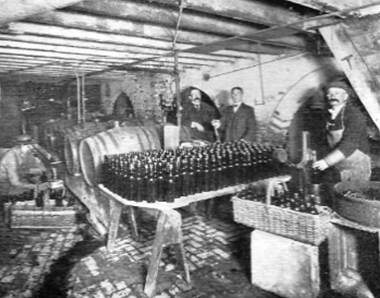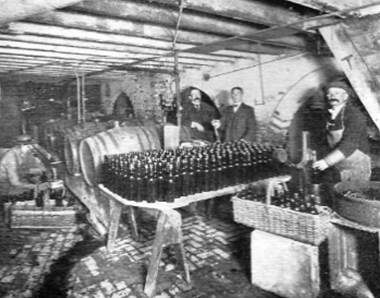The genealogy of the line of
Farndales, descended from John Farndale and Elizabeth Wallace
|
Return to the Home
Page of the Farndale Family Website |
The story of one
family’s journey through two thousand years of British History |
The 84 family lines
into which the family is divided. Meet the whole family and how the wider
family is related |
Members of the
historical family ordered by date of birth |
Links to other pages
with historical research and related material |
The story of the
Bakers of Highfields, the Chapmans, and other related families |
This webpage comprises the genealogical family tree
of the Stockton 1 Line and then summarises the deeper ancestry of this
line of the Farndales.
John Farndale was a farm labourer and worked in an iron foundry who lived
in Hinderwell/Roxby, then briefly at Kirkleatham before settling in Stockton. He had a family of ten.
The family tree is colour coded to show the flow of relationships between
individuals. You can also follow the hyperlinks in brown text
to link directly to other related family lines and the hyperlink in blue text to
reach the webpage of each individual, where you can read about their lives in
more detail.
|
|
|
|
|
|
|
|
|
|
|
|
|
|
|
|
John
Farndale 16
March 1796 to 28 October 1868 Married
Elizabeth Wallace (sometimes Wallis) on 30 December 1827 Farmer,
farm labourer, iron foundry labourer Stockton,
Brotton, Kildale, Barnby, Roxby, Whitby, Kirkleatham |
|
|
|
|
|
|
|
|
|
|
|
|
|
|
|
|
|
John
Farndale 30
August 1829 to 10 May 1899 Married
Ann Thrattles on 16 July 1854 and then Ellen Thrattles on 7 December 1873 Grocer’s
warehouseman of Stockton. When his wife died, he married his sister in law Kildale,
Great Ayton, Kirkleatham, Redcar, Stockton |
George
Farndale 1835
to 1887 Married
Catherine Wemyss Leng on 5 August 1865 Druggist
and grocer who suffered bankruptcy, and the tragic death of his three
daughters in the 1874 pandemic Roxby,
Hinderwell, Stockton, Barnby, Liverpool, Middlesbrough, Gateshead, Rothbury,
Northumberland |
Mary
Farndale 1837 Married
Thomas Dods in 1855 Roxby,
Scaling, Hinderwell, Guisborough |
Jane
Farndale 1838
Roxby,
Kirkleatham, Stockton |
Peter
Wallis Farndale 14
February 1839 to 23 April 1840 Died
aged 1 Boulby, Hinderwell |
Hannah
Farndale 1840
to 4 April 1845 Whitby |
Sarah
Farndale 1843
to 4 April 1845 Roxby,
Whitby |
Sarah
Farndale 1846 Married
Jesse Howarth or James Bowden in 1873 Roxby, Stockton |
William
Farndale 6
July 1845 to 1 August 1895 Solicitor’s
clerk Kirkleatham,
Coatham, Stockton |
Peter
Farndale 13
November 1847 to 18 June 1896 Married
Margaret Duncan Devereaux on 9 January 1879 Solicitor’s
clerk of Stockton Stockton,
Kirkleatham, Guisborough |
|
|
|
|
|
|
|
|
|
|
|
|
Mary
Ann Farndale 14
April 1856 to 1933 Married
Ralph Gibbon on 28 March 1880 Moved
back to the Farndale hub of Kilton in about 1881 Redcar,
Stockton, Kilton, Guisborough, Brotton |
William
Ralph Farndale 28
March 1858 to 3 May 1870 Died
aged 11 Stockton |
Jane
Ellen Farndale 17
January 1864 to 1951 Servant
to the butcher of Billingham Stockton,
Billingham, Middlesbrough, South Shields, Leyburn, Wensleydale |
Sarah
Hannah Farndale 30
January 1867 to 1953 Married
Alfred Wilks Windross, who ran a book binding business, in 1889 Stockton,
Hartlepool |
Margaret
Elizabeth Farndale 3
July 1869 to 4 October 1948 Unmarried Stockton,
York, Leeds, Blackburn |
|
|
|
|
|
|
Mary
Ann Gibbon
(Born 1882), John William Gibbon (Born 1886), Jane Ellen Gibbon
(Born 1889) |
|
|
Gertrude
Ellen Windross
(Born 1891), Ivy Ann Windross (Born 1894, later Ivy Arnold), Alfred
Farndale Windross (Born 22 December 1895) |
Mary
Frances Farndale 1867
to 17 December 1874 Died
aged 7 and buried on the same day as her 4 year old sister Stockton There
was a smallpox pandemic in 1870 to 1874, which originated in France. The
Vaccination Act 1853 helped to mitigate its effect in England, but perhaps
this was the cause of three (or perhaps four) sisters dying the same year.
There was also a cholera epidemic at the time. |
Catherine
Wiley Farndale 1870
to 17 December 1874 Died
aged 4 and buried on the same day as her 7 year old sister Stockton |
Annie
Louisa Farndale 18
February 1872 to 26 December 1874 Also
died and buried with her sisters in late 1874 Stockton |
Emily
Farndale 12
September 1872 to 12 September 1872 The
records don’t confirm Emily’s parents’ identity, but it is possible she was
another daughter of George and Catherine (and was likely to have been this
wider family) |
1876
to 9 May 1932 Brewer
and wine merchant and later a Brewer’s Merchant in Rothbury Married
Margaret Ann Davison in 1896 Middlesbrough,
Sunderland, Rothbury |
|
|
|
|
|
|
|
|
|
|
|
|
|
|
|
|
|
|
|
|
|
|
|
|
|
|
|
|
|
|
|
|
|
The
Deeper Ancestry of the Stockton 1 Line
The matrix below
will transport descendants of the Stockton 1 Line into a personal
journey into their deep ancestry. It is an extract of the Farndale Story
which is bespoke for the Stockton 1 Line descendants. It will take you back to
the earliest history of our ancestors and each box will transport you to a more
detailed narrative to unlock your history.
|
|
|
|
A
Time Machine to a different era of geological time in the heart of our
ancestral home |
|
|
|
|
|
|
|
The Iron Age, Bronze Age, Neolithic, and Mesolithic
evidence of the people of the immediate vicinity to Farndale |
|
|
|
|
Isurium Brigantum (Aldborough) The
Roman Regional Capital of the lands around Kirkdale |
A
Roman Villa on palatial scale just south of Kirkdale |
A
Roman Villa only 2km from Kirkdale in the heart of our ancestral lands |
71 CE to 580 CE The lands which would become the lands of Kirkdale
and Chirchebi in Roman and Pagan times |
A Roman arm purse which can be seen in the British
Museum in London today, found in about the second century CE by a cairn
overlooking Farndale, which will transport you back 2,000 years |
The
Roman Capital of northern England where Constantine was proclaimed Emperor |
|
|
|
|
|
560 CE to 793 CE Kirkdale and the Chirchebi Estate in the
Anglo Saxon Period |
Kirkdale
from its founding in about 685 CE to the beginning of the Scandinavian period
in about 800 CE |
Deirian and Northumbrian York, a political,
cultural and educational Hub on the European stage The
people who dominated our ancestral lands |
Alcuin and the birth
of modern education
The
world of Ecgbert and Aethelbert, successors to Bede, and their pupil Alcuin,
who took York’s powerhouse of knowledge to the court of Charlemagne to
pioneer the European educational system |
|
|
|
The
powerful figure at the heart of the aristocracy, who rebuilt Kirkdale and put
our ancestral lands firmly onto the national political stage |
793 CE to 1066 Kirkdale and the Chirchebi Estate in the
Scandinavian Period |
Anglo-Saxon-Scandinavian
Kirkdale Kirkdale
in the Anglo-Saxon-Scandinavian period from about 800 CE to 1066, with a
brief summary of its history through to 1500 |
The
Scandinavian centre of northern England |
A unique treasure whose secrets transport us into the
world of the eleventh century upon which you can stare today, imagining
direct ancestors who did the same a thousand years ago |
|
|
|
Regime
Change |
1066 to 1200 The People of the Kirkbymoorside (“Chirchebi”)
Estate after the Norman Conquest |
This
history of the Cistercian monastery of Rievaulx, in whose Chartulary the name
Farndale was first recorded in 1154 |
|
|
|
Our Pioneer ancestors who left Farndale but took
its name to settle in new places |
Tales of a surprisingly large number of our
forebears who were poachers in Pickering Forest. Their archery skills would
foretell the legends of Robin Hood and the English army at Agincourt |
Rural
lifestyles from the Norman Conquest |
A model which
relies on extensive medieval evidence, to suggest the most probable family
tree of the earliest ancestors of the Farndales |
Thirteenth
Century Farndale
Clearing the dale to build our new home |
The
story of the dale of Farndale to 1500, to accompany the family story |
Tales of archers and men at arms who fought with
Richard II, Henry IV and Henry V and an observation post in the home of the
Nevilles and Richard III from which to view the Wars of the Roses |
|
The
history of the village of Campsall north of Doncaster, where we find our
ancestors in the sixteenth century |
The History of Doncaster to 1500 The
History of pre industrial Doncaster from its Roman inception as Danum
to the end of the sixteenth century |
The Family of William Farndale, the Fourteenth
Century Vicar of Doncaster |
|
Arrival in the old Bruce lands around Skelton Castle The Sixteenth and Seventeenth Families of
Kirkleatham, Skelton, Moorsholm and Liverton in Cleveland |
A history of Kirkleatham and Wilton, the place where
our family first settled in Cleveland |
|
|
|
|
|
|
|
|
|
|
The family
story of mining, mainly for ironstone, the primary resource behind the
industrial development of Cleveland |
Transition to the Industrial Revolution John
Farndale, my great x2 uncle, was a prolific writer who captured the essence
of the late eighteenth century and its transition into the Industrial
Revolution. The family’s history provides a direct pathway to experience
these years of momentous change |
Three generations of Kilton Farndales in one place. A side trip to nearby Boosbeck and Skelton take you to
the gravestones two later generations. Take in Wensley and you’ll find two
more recent generations. Seven generations of the family in one short drive |
|
The First Hub The story of the Kilton Farndales, a family who
dominated a village, since lost to time, over two centuries |
The
story of the lost village of Kilton and its sylvan landscape A journey around modern Kilton, of farms, a ruined
castle and a small village of Kilton Thorpe to capture the essence of the two
century home of Farndales |
Stories
of smugglers, led by my great x3 grandfather known as the King of the
Smugglers, and the undoubted involvement of our forebears |
|
|
|
Spreading out from Brotton and Loftus The Second Hub The story of a substantial division of the family who
spread widely across Cleveland and beyond from Kilton, Brotton and Loftus |
|
|
|
|
|
|
The family story of mining, mainly for ironstone,
the primary resource behind the industrial development of Cleveland |
Transition to the Industrial Revolution The family’s history provides a direct pathway to
experience these years of momentous change |
||||
|
|
1912 to 1944
An airman shot
down over Denmark after a bombing raid, and secretly buried by the Danish
resistance
The story of the
shooting down of Lancaster ME 718 |
|
|
|||
|
|
The many families who lived in Leeds, Bradford,
Coatham, Middlesbrough, Hartlepool and Stockton through the period of
industrial transition |
The Stockton 1 Line |
1876 to 1932
Brewer and
Northumberland Hussar of Rothbury, Northumberland |
|































